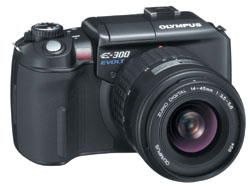 |
|
|||||||
|
Reviews
OLYMPUS E-300 I couldnāt believe how good this camera felt÷and kept on feeling÷after I went for a three-hour walk with it and shot a couple of hundred pictures. True, itās not a point-and-shoot featherweight, but unlike some other dSLRs Iāve used lately, it wonāt drag you to the bottom of the lake if you fall in. The E-300 is a very different looking dSLR because it has shed the hump that most others have always carried as a genetic trait. It doesnāt need that headroom because its mirror flips to the side (instead of up like the others) when you press the shutter release button. Internal optics that allow you to see the image correctly in the viewfinder have been buried in the body of the camera which makes the E-300 more streamlined. Itās a design Olympus pioneered over 40 years ago on its legendary Pen F, a half-frame film SLR, and it also seems to quiet the camera considerably÷the loud mirror slap characteristic of most dSLR cameras has been reduced to a muffled pop. The E-300ās all-aluminum body has a solid feel and can take moderate abuse, but donāt push it÷itās not made to stop bullets like the Olympus E-1 which is built as a professional ćbring-em-onä camera. Unless youāre heading for Iraq this shouldnāt be an issue. The front of the camera is totally clean, with only the lens release button showing; youāll never have to tilt the camera to find any out-of-the-way controls there. The top deck is almost as Spartan÷thereās an on-off switch, a Mode dial and a Control dial, all neatly clustered on the right-hand side with the shutter release button just forward of them. If youāre a beginner, just pick a scene mode (there are five of them marked on the dial) and shoot. You have a choice of portrait, landscape, macro, action, and night scenes. Not enough? Venture into the menu and youāll find a total of 14, each with a description and sample photo. Of course if youāre an old hand, there are the usual advanced modes: Program, Aperture and Shutter Priority, and Manual. In Program, spinning the Control dial will shift exposure combinations so you can choose either the lens opening or shutter speed you want to shoot at and the other will follow along. Or for more control, simply switch to Aperture Priority, Shutter Priority, or Manual and lock in the setting (or settings) of your choice. At the back of the E-300, youāll find more buttons, perfectly laid out for fast and easy operation. Unlike most dSLRs that have the image review button on the extreme left of the camera (forcing you to move your left thumb down a series of buttons until you hit the right one), the E-300ās button is always next to your right thumb. Hereās the drill: shoot, tilt the camera slightly forward, press the review button, and your picture is displayed. Perfect placement. Of course you can also set the camera for automatic review of each image. The cameraās Control dial is also within easy reach of your right thumb. Itās used to select apertures, shutter speeds, ISO, and all the other choices that are first set in motion by pressing the appropriate button and then rotating the dial. It also handles zooming in and out on images (up to 10x) in playback mode. Moving down from the Control dial youāll find an auto exposure lock button and a selection button for designating the part of the frame the camera will pick for autofocus (set it at center and leave it there). The menu button is located under the playback button÷just slide your thumb down a hair and youāre there. Below it are four more buttons, laid out like points of the compass, that allow instant access to exposure compensation, ISO, metering mode (evaluative, center or a very accurate 2-degree spot), and your focus mode (single frame shooting, motion tracking or a combination of both). Beneath those is an ćOKä button to confirm menu choices. You can also assign the ćOKä button to different functions÷such as depth of field preview÷when itās not being used to confirm menu choices. Before moving to the last four buttons on the other side of the camera, letās look at the LCD monitor. Instead of a separate status LCD, most of which are a real pain to read with their black-on-olive backgrounds, the E-300 uses the LCD monitor itself. Letās say you want to know what ISO youāre shooting at. Just press the ISO button and the LCD lights up like a beacon with the answer. To change it to a different setting, twirl the Control dial and itās done. To get a read-out of all critical functions, simply press the Info button on the left side of the camera and theyāll all be displayed: Exposure compensation, flash intensity, focus mode, resolution, ISO, white balance, color space, and the number of exposures left. Youāll also get a readout of your lens aperture and shutter speeds. All in big, bright, easy-to-read letters on a black or blue background with the most important ones highlighted in yellow. Now letās run down the left hand side of the LCD monitor. There are five buttons that handle flash mode, white balance, resolution choice, image erasing, and picture information. The Info button lets you toggle through six screens of data, each with ever-increasing details. One is dedicated to a histogram, another blinks in overexposed areas , still another gives exposure information, and so on. Thereās not much you wonāt know about the pictures youāve shot. The E-300 has a built-in, pop-up flash whose intensity can be controlled automatically or manually. The manual options give you full flash, 1/4, 1/16, and 1/64 intensity which are excellent when working close to subjects or objects. Thereās also a hot shoe for a more-powerful external flash and, because it is offset from the cameraās flash, both can be used together if desired. Thereās no pc socket for connection to professional studio strobes, but itās no big deal because you can get an inexpensive pc adapter that slides onto the flash shoe if you need one. There are a few quirks that mildly annoyed me (arenāt there always?). The E-300ās on-off switch (which is to the right side of the Control dial) operates counter-intuitively. You have to dig around behind it and push it forward, usually getting your finger caught in the camera strap. Just pulling back the lever to turn the camera on would be much faster. And I didnāt like manual focus÷too many turns were required to get the image to snap in. Finally, the heads-up lighted display in the viewfinder runs down the right side of the image. Which means it is more difficult to see than those in previous Olympus dSLRs where they are positioned under the image.
Of course the real test of a camera is image quality and ease of use. The E-300 gets full marks for those. The camera is ready to go in less than a second after being turned on÷and each time that happens, its Supersonic Wave Filter cleans the sensor of any dust that may have accumulated on it. Thereās no noticeable shutter lag and shot-to-shot time is as fast as you can press the shutter button. But in sequential mode, you can only fire off four pictures at 2.5 frames-per-second; you can continue to take single shots as the buffer clears, after which you can shoot another burst of four. For maximum transfer speed, I used a Sandisk Ultra II memory card. I shot with the E-300 under both good and difficult lighting conditions and the resulting pictures were outstanding. It even did all right at ISO 400 though above that it was a bit noisy. I used the kit lens, an f-3.5/5.6 Zuiko 14ö45mm that has a 35mm focal length equivalent of 28ö90mm. With 8MP to play with, I had plenty of pixels left even when I cropped some pictures severely. Thereās nothing as exciting as finding new pictures within the pictures youāve shot, and then be able to blow them up to a reasonable size without them looking like a checkerboard. Thatās where high megapixel cameras like the E-300 really shine. To sum up, I liked the E-300ās light weight, fast operation, buttons in the right places, and quietness. I could carry it around all day without the slightest feeling of fatigue. Its LiIon battery kept going well beyond 500 shots, and the camera gave an adequate warning that allowed me to continue taking more pictures before I swapped the battery for a fresh one. The metering system performed well, color was right on, and images, when blown up, were as good or better than film÷with an impressive dynamic range that gave good shadow detail without blowing out highlights. With the E-300 Evolt Olympus has come up with an ideal reflex camera for serious photographers at a very affordable price. If youāre ready to step up to an 8MP digital SLR, the E-300 is an exceptional camera that will give you superb images and help you achieve your creative vision. |
|||||||
|
|
|||||||
|
©
2004 D.C. Publications, Inc. All Rights Reserved. |
|||||||


 How
about an 8MP dSLR with a 28ö90mm (35mm equivalent) zoom lens that
weighs only two pounds and carries a price tag of US $999? Interested?
Then pay attention, because the Olympus E-300 may just be what youāve
been waiting for.
How
about an 8MP dSLR with a 28ö90mm (35mm equivalent) zoom lens that
weighs only two pounds and carries a price tag of US $999? Interested?
Then pay attention, because the Olympus E-300 may just be what youāve
been waiting for.